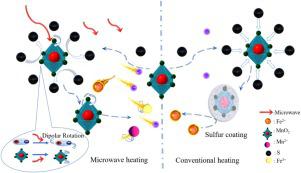Chemical Engineering and Processing: Process Intensification ( IF 3.8 ) Pub Date : 2020-10-31 , DOI: 10.1016/j.cep.2020.108209 Shunda Lin , Kangqiang Li , Yong Yang , Lei Gao , Mamdouh Omran , Shenghui Guo , Jin Chen , Guo Chen

|
The recovery mechanism of manganese from low-grade pyrolusite was studied through microwave and conventional leaching, respectively, and pyrite was used as the reducing agent. An improvement on the manganese leaching rate with microwave heating was noticed which may be caused by the suppressing of the formation of sulfur passivation layer by the unique dipole rotation heating mechanism of microwave energy. To confirm this hypothesis, the leaching time, the amount of reducing agent, and the concentration of sulfuric acid were studied, and the surface compositions of the leaching residues were analyzed. The results evidenced that the sulfur content on the surface of residue produced by microwave leaching was significantly reduced compared to the results produced by conventional heating, which proved the rationality of the hypothesis. The recovery of leaching assisted with microwave heating was improved compared to that assisted with conventional heating under the same experimental conditions (liquid-solid ratio: 10:1, leaching temperature: 90 ℃, M(pyrite)/M(pyrolusite): 0.2, sulfuric acid concentration: 1.2 mol/L, stirring speed: 400 rpm). The corresponding peak value of the leaching rate was 95.07% and 75.08%. Additionally, microwave leaching is very environmentally friendly since it significantly reduces the amount of reducing agent and sulfuric acid as well as reaction time.
中文翻译:

以黄铁矿为还原剂从低品位软锰矿中选择性强化浸出的微波辅助方法研究
通过微波和常规浸出研究了低品位软锰矿中锰的回收机理,并以黄铁矿为还原剂。注意到通过微波加热提高了锰的浸出速率,这可能是由于独特的微波能量偶极子旋转加热机制抑制了硫钝化层的形成。为了证实该假设,研究了浸出时间,还原剂的量和硫酸的浓度,并对浸出残渣的表面组成进行了分析。结果表明,与传统加热相比,微波浸出产生的残渣表面硫含量显着降低,证明了该假设的合理性。(黄铁矿) / M (软锰矿):0.2,硫酸浓度:1.2 mol / L,搅拌速度:400 rpm)。浸出率的峰值分别为95.07%和75.08%。另外,微波浸提非常环保,因为它显着减少了还原剂和硫酸的量以及反应时间。











































 京公网安备 11010802027423号
京公网安备 11010802027423号